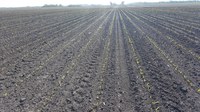NDSU Makes Corn Planting Recommendations
(Click the image below to view a high-resolution image that can be downloaded)
North Dakota growers have declared their intentions of planting more than 4 million acres of corn this year, according to the U.S. Department of Agriculture’s prospective plantings report.
Planting this record number of acres will be especially challenging due to the cold and wet weather this spring, and the fact that many acres were not tilled last fall due to wet conditions that delayed the harvest of soybeans and corn, says Joel Ransom, North Dakota State University Extension agronomist.
The optimum period for planting corn in North Dakota is during the first three weeks of May. Early planting allows for the use of full-season hybrids that are able to maximize the use of sunlight and favorable temperatures during the growing season.
“When corn planting is delayed beyond May 20, growers in the northern tier of counties should consider switching to another crop,” says Ransom. “Growers in the rest of the state should consider switching to a hybrid that is 5 to 7 days earlier in maturity to avoid corn that is so wet that it makes harvesting in the fall challenging and the grain expensive to dry.”
He continues, “Planting corn after June 1 can be risky and is only recommended in the most southern regions of the state, using hybrids that are 80 relative maturity (RM) or earlier. Even though we are now in the recommended planting window for corn, conditions for corn growth are not favorable.”
Corn germination does not begin until soil temperatures warm to 50 degrees, and corn seedlings require about 110 growing degree-days before they will emerge.
Ransom suggests planting when conditions are suitable, even though soils may be below 50 degrees, as soils can warm quickly once the sun comes out. When soils are still cold, don’t plant prior to a rain or snow event, cautions Ransom, as seeds that imbibe cold water may suffer from imbibition chilling injury.
“For fields that have not yet been fertilized, I recommend planting prior to applying nitrogen (N) fertilizer rather than waiting days for a fertilizer application,” says David Franzen, NDSU Extension soil fertility specialist. “There is sufficient N in the soil to support developing seedlings for several weeks without any yield reduction.”
Growers, however, should have a plan for side dressing N later in the season before corn plant demand outstrips the soil’s ability to supply it. Tillage may be helpful in hastening soil drying and burying residues that slow soil warming.
In no-till fields or in fields that growers are thinking of planting without normal deep tillage, use of a shallow tillage tool, like a vertical tillage implement, may be effective in speeding drying.
However, tilling when soil conditions are too wet can result in serious tillage compaction and may produce large clods that will make planting difficult, says Aaron Daigh, NDSU soil scientist.
For growers who can access the proper equipment, planting corn no-till may be the best way to get corn planted in a timely fashion in soils that have not been tilled.
In addition to early corn planting, achieving good plant stands with uniform emergence timing are factors that contribute to high yield potential.
To increase plant stands and encourage emergence uniformity, Ransom suggests keeping these recommendations in mind when planting corn this spring:
- Avoid tillage when soils are wet as it may produce hard soil with large clods that will impact seeding depth and soil-seed contact. A wet-dry cycle, at least in eastern soils, will largely heal the condition, but we sometimes do not receive rain when we need it.
- Plant at an optimum depth for conditions. Soil temperature and soil moisture are two factors to consider when deciding on an optimum seeding depth, but plant at least 1.5 inches deep to avoid “lazy corn syndrome.”
- Avoid planting when it is too wet. This may cause side wall compaction resulting in the seed furrow remaining partially open.
- Adjust seed openers and/or press-wheel pressure to improve soil-seed contact.
- Do not plant too fast. Even with today’s planters, planting too fast for the conditions will result in uneven seeding depth and possibly poor soil-seed contact.
- Properly adjust residue managers so that surface residue is removed and the soil directly above the seed row is free from residues that may inhibit soil warming.
NDSU Agriculture Communication – May 3, 2019
| Source: | Joel Ransom, 701-231-7405, joel.ransom@ndsu.edu |
|---|---|
| Source: | David Franzen, 701-799-2565, david.franzen@ndsu.edu |
| Source: | Aaron Daigh, 701-231-8354, aaron.daigh@ndsu.edu |
| Editor: | Kelli Anderson, 701-231-6136, kelli.c.anderson@ndsu.edu |


